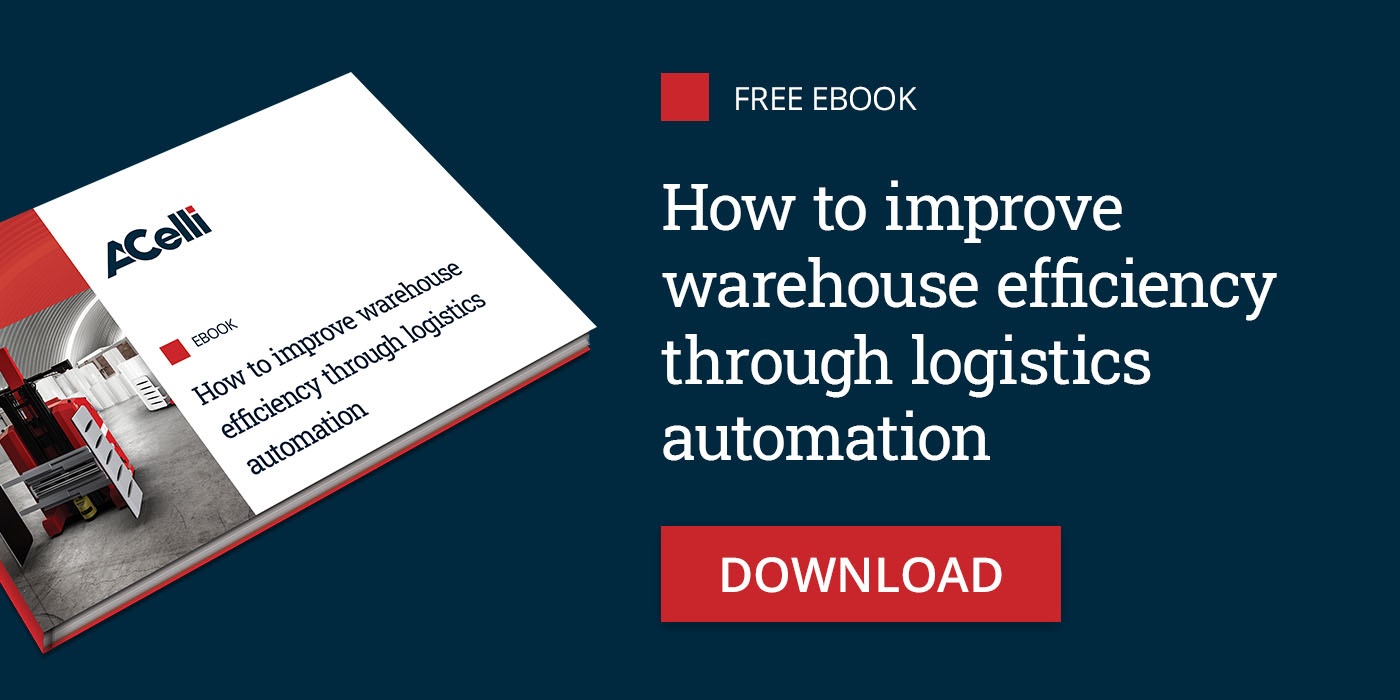[UPDATED ON APRIL 2022]
Material handling (also called intralogistics) represents an increasingly strategic choice for companies that produce and sell tangible goods, since the optimisation of all the procedures can speed up operation times, cut costs and improve customer service. But how can this be done?
The tools available to optimise management of warehouses, fortunately, now abound. Some are for storage (mobile shelves), others for monitoring the premises, machines and data (sensors, management software), and others again are meant to be used by the workforce (wearable devices, Beacon receivers), but the instruments for automated material handling systems arguably represent the lion's share.
Automated material handling systems in a nutshell
You can't really have a fully automated warehouse without transforming the intralogistics operations. The storage and handling of pallets, packages and other objects involve time and energy. The work can often require either strength or extreme care (such as rolls of paper or tissue, which must not be damaged or soiled), or both. And machines can carry out these operations in a manner that is efficient, precise, cost-effective and safe.
- Efficient, because the efficiency of a machine is certain and calculable while that of an operator is subjective and variable.
- Precise, because the natural margin of human error disappears and the goods are delivered automatically to the correct storage or picking stations.
- Cost-effective, because it can replace manual labour for repetitive, heavy and low grade work.
- Safe, because employees no longer have to perform potentially dangerous operations.
In addition to this, automated systems are equipped with tools that can weigh, sort and group the goods.
Let us look at the essential tools for an automated material handling system: shuttles, conveyors with a decision point, and AGVs (automated guided vehicles).
1. The shuttles
Warehouse shuttles typically do not fear heavy loads: depending on the "tonnage", they can move large pallets or packages weighing anything from a few quintals to a few tons. They are ideal, therefore, for companies that have to manage a high volume of pallets and intense loading/unloading activities.
The classification of shuttles varies from manufacturer to manufacturer, but broadly speaking we can make a distinction between models for "horizontal" transport and models that move materials from bottom to top and vice versa, commonly used in vertical warehouses with many shelves stretching from the floor almost up to the ceiling.
A shuttle typically comprises traction and lifting motors, mechanisms for hooking the goods (usually fork-shaped), driving controls (joystick and/or instrument panel with display and buttons) and a space for the personnel (cabin, seat or platform, depending on the model and trajectory).
2. Conveyors with decision points
Conveying systems, essential in the production department and symbolic almost of the industrial assembly line, are also very useful in warehouses for transferring goods from "A" to "B", in the simplest scenario, as well as along more complex paths. Roller conveyors and conveyor belts, in fact, not only move forward or backward quickly or slowly, but also sort, weigh and measure. Typically they are systems that require little maintenance and do not significantly add to the running costs of the warehouse.
The mechanical activity of moving on a sliding belt is associated with a "logical" activity, entrusted to decision points. These are elements at key points of the system where decisions are made (such as that of sorting items and sending them to a destination) and where it is necessary to communicate the passage or weight of goods. The combination of these elements and the modular design of the conveyor belts makes it possible to set up the most suitable conveying system in terms of configuration, distance, trajectories, speed and actions for the handled goods.
The trend is to limit conveyors to the points at which the material enters and leaves the modern warehouse, to occupy the least possible space and ensure maximum flexibility of the warehouse area.
3. AGVs (Automated Guided Vehicles)
Automated guided vehicles are perhaps the most advanced form of automated material handling equipment. They come in all shapes and sizes and with driverless technologies: they orientate themselves by means of sensors that provide information on the guide path between the points of departure and arrival.
- Some AGVs are equipped with optical sensors that allow them to follow the path of a reflective strip on the ground and read any barcodes along the way at points where it is necessary to take a "decision", like turn right or left or around an object, or simply stop.
- Vehicles with magnetic sensors, instead, orientate themselves according to magnetic references on the floor. In this case, too, it is possible to place markers that transmit specific instructions at crossroads, obstacles or points of arrival.
- A third type of AGV is equipped with Gl sensors (Grid Localisation Sensors) which allow the vehicle to identify its position by reading codes on the floor. In recent years, a so-called natural navigation guide has been perfected which does not require physical reference points as the area is mapped and stored in a memory to create the necessary references for navigation. The latest technology still does not allow for levels of precision obtained with other systems, so natural navigation is currently used in combination with other more precise guidance systems.
- The most commonly used navigation system for industrial applications remains the laser system. A series of reflectors around the perimeter make it possible to detect the position of each individual vehicle in real time by means of a triangulation system. To avoid accidental collisions with people or objects, the vehicles are equipped with safety systems such as flashing lights, audible warning devices, side skirts, physical bumpers and virtual bumpers with laser technology.
Read more: Automatic Guided Vehicle: definition and most useful types in the warehouse
From Material Handling to the automation of all logistics
Material Handling, as we have seen, has several cards up its sleeve to win the game of efficient logistics, optimised in terms of costs, space and processes. And since no two warehouses in the world are the same, it is important to choose and configure the solutions best suited to the specific space, goods and operations concerned. However, Material Handling is only one of the dimensions of the technological and organisational revolution known as the automated warehouse.
If you would like to find out more, we invite you to read our free eBook on how to improve warehouse efficiency through logistics automation.

